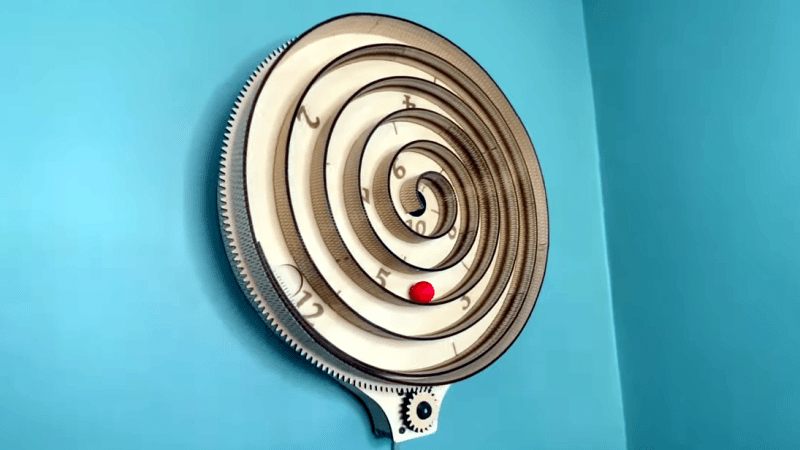[Build Some Stuff] created an unusual spiral clock that’s almost entirely made from laser-cut wood, even the curved and bendy parts.

The clock works by using a stepper motor and gear to rotate the clock’s face, which consists of a large dial with a spiral structure. Upon this spiral ramp rolls a ball, whose position relative to the printed numbers indicates the time. Each number is an hour, so if the ball is halfway between six and seven, it’s 6:30. At the center of the spiral is a hole, which drops the ball back down to the twelve at the beginning of the spiral so the cycle can repeat.
The video (embedded below) demonstrates the design elements and construction of the clock in greater detail, and of particular interest is how the curved wall of the spiral structure consists of a big living hinge, a way to allow mostly rigid materials to flex far beyond what they are used to. Laser cutting is well-suited to creating living hinges, but it’s a technique applicable to 3D printing, as well.
Thanks to [Kelton] for the tip!

















That’s one of the most fun clocks I’ve ever seen.
Just for the love of god get rid of those laser cutting burn marks… Laser cutters are a great fabrication tool, but most of the time the result can do with some proper finishing.
I didn’t notice any particularly bad ones. What works for me, though, is to put down transfer paper on the wood before loading it into the laser (both sides if you are cutting through). Then the burn marks come off with the tape.
I think he’s referring to the edges rather than smoke damage. Maybe he thinks the wood grain is smoke or something.
I’ve always found the char-marks from the laser to be visually pleasing — nice contrast with the light colored wood.
Laser charring gives a similar impression as building with meccano or some other toy construction set. It reminds me that the object is a sort of approximation or a compromise of what it’s “really” supposed to be like, because you just can’t do better with a laser cutter and plywood alone.
The black edges gives it definition, makes it “pop” if you like. Here’s a little deer head in MDF: https://www.dropbox.com/scl/fi/tywwp9zqndf34kx7gs2o9/Deer-MDF.jpg?rlkey=4vmu0qn5d2axsj05mat50gspy&dl=0
Same thing in yellow acrylic: https://www.dropbox.com/scl/fi/nlshofaaupynz0tya5bte/Deer-yellow.jpg?rlkey=cy76o1dqo5jiay6fosuouh0xq&dl=0, yeah nah.
Tried a few other colours, the neon acrylic sort-of works because the edges light up: https://www.dropbox.com/scl/fi/73uo7wxrl7roj1paj7n57/Deer-neon-pink.jpg?rlkey=oylz82bkmje8wo7dwo8s057ic&dl=0
Neat ‘unique’ project. Never saw this type of ‘clock’ before.
I don’t mind the burn marks in this use case. Actually looks good here. Same with all those ‘Wood Trick’ models.
Now on my R/C airplane kits, I like to sand off the dark areas as it shows through the covering material which isn’t as nice.
I’ve noticed nowadays many creators leave wood and 3d printed parts unfinished. You can do a little sanding or throw on a coat of spray paint. But this is a great build nonetheless.
I think in a world of mass-produced objects some folks like to emphasize the bespoke nature of their creations. If you spent too much time on finishing it looks like a factory-produced object, not something you made yourself.
I mean there’s a time and a place for glossy professionalism. But if you’re using a laser-cut living hinge in your design it seems you’re intending to show off “how it was made” not cover it up.
If it was cheaply mass-produced out of plywood, it would be made on a laser and look exactly like this.
Love the idea. One could even add a minute “hand” below the motor
What about some gearing and minute “ball”?
A clear acrylic sheet between the hour and minute hands would look nice.
Nice, but I think I’ll have the original…
$540! Where are those CAD files again!
Okay, this just makes me smile.
It reminds me of the spiriform watch that… I think it’s just Arthur Dennison, not his son Will, gets at the beginning of the first Dinotopia book. (Dang it’s been too long.) I read those books when I was a lot younger… always wondered how the watch worked. Somehow, a bead set in a marked channel never quite occurred to me…
Ahhh, those were better days. I miss those days.